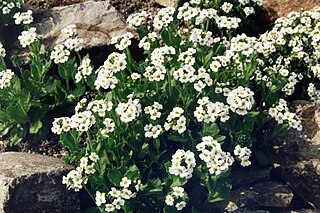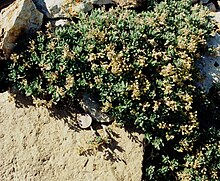
Draba aizoides is a species of Draba, known as yellow whitlow-grass. It is native to Europe where it is found on limestone rocks and walls. In the British Isles it is found only on the Gower peninsula.

The Tushar Mountains are the third highest mountain range in Utah after the Uinta Mountains and the La Sal Range. Located in the Fishlake National Forest, Delano Peak, 12,174 ft NAVD 88, is the highest point in both Beaver and Piute counties and has a prominence of 4,689 ft. Delano Peak is named for Columbus Delano (1809–1896), Secretary of the Interior during the Grant administration. The Tushars receive an ample amount of snow annually even though they are situated within the rainshadow of the Sierra Mountain Range located in California and the Snake Range located in Nevada.

Draba aureola is a species of flowering plant in the family Brassicaceae known as the Mt. Lassen draba or Mt. Lassen whitlow-grass. This plant is native to the Cascade Range of western North America, where it grows at elevations above 2000 meters. This is usually a perennial plant found growing in rocky areas such as volcanic cliffs and scree. It has one or more short, stout stems which are covered in stiff hairs. The leaves grow in a dense basal clump at the ground. They are fat and fleshy and covered in a carpetlike coat of stiff, light colored branching hairs. The stem may be erect above the clump of leaves or its inflorescence may rest directly upon them. The spherical or club-shaped inflorescence may have up to 80 small yellow flowers packed densely in it, each petal about 5 millimeters wide. The fruit is a wavy-edged, hairy silique about a centimeter long and half a centimeter wide.
Draba breweri is a species of flowering plant in the family Brassicaceae known by the common names cushion draba, Brewer's draba, and Brewer's Whitlow grass. With Draba cana now considered a variety of this species, it is distributed throughout parts of northern and western North America, including much of Canada and the western United States. The less widespread var. breweri is limited to mountainous California and western Nevada.

Draba carnosula is a rare species of flowering plant in the family Brassicaceae known by the common name Mt. Eddy draba. It is endemic to the Klamath Mountains of far northern California, where it is known from fewer than twenty occurrences at Mount Eddy and other peaks in the range. This is a perennial herb forming small clumps in serpentine outcrops. The leaves are located at the base of the plant, each an oval shape under a centimeter long. They are mostly hairless, except for long hairs along the edges. The erect inflorescence bears fewer than 10 yellow mustardlike flowers. The fruit is a lance-shaped silique one or two centimeters long, containing several winged seeds.
Draba incrassata is an uncommon species of flowering plant in the family Brassicaceae known by the common name Sweetwater Mountains draba.

Draba monoensis is an uncommon species of flowering plant in the mustard family known by the common names White Mountains draba and Mono draba.
Draba sharsmithii is an uncommon species of flowering plant in the family Brassicaceae known by the common names Mt. Whitney draba and Sharsmith's draba.
Cymopterus goodrichii is a rare species of flowering plant in the carrot family known by the common name Toiyabe springparsley. It is endemic to Nevada in the United States, where it occurs in the Toiyabe and West Humboldt Ranges.
Draba serpentina is a species of flowering plant in the family Brassicaceae known by the common name serpentine draba. It is endemic to Nevada in the United States, where it occurs in the Snake Range in White Pine County and the Toiyabe Range of Lander County.
Packera castoreus is a rare species of flowering plant in the aster family known by the common names Beaver Mountain groundsel and Beaver Mountain ragwort. It is endemic to Utah in the United States, where it occurs only in the Tushar Mountains.
Primula capillaris is a rare species of flowering plant in the primrose family known by the common name Ruby Mountains primrose, or Ruby Mountain primrose. It is endemic to Nevada in the United States, where it is limited to the Ruby Mountains of Elko County.

Draba fladnizensis is a species of plant in the family Brassicaceae known by the common names arctic draba, Austrian draba, and white arctic whitlow-grass. It has a circumpolar distribution, occurring throughout the northern latitudes of the Northern Hemisphere. It is present in Europe, Asia, and North America from Alaska across northern Canada to Greenland. Its distribution extends south through the higher elevations in the Rocky Mountains to Colorado and Utah. It is common and widespread in the Canadian Arctic Archipelago, occurring on several Arctic islands including Baffin, Devon, and Ellesmere Islands. It is named after the Austrian village of Flattnitz, in the Gurktaler Alpen.
Draba burkei is a species of flowering plant in the family Brassicaceae known by the common names snowbasin draba and Burke's draba. It is endemic to Utah in the United States, where it is known from Box Elder, Cache, Morgan, and Weber Counties. This plant was considered a variety of Draba maguirei until 2004, when it was elevated to species status.
Draba exunguiculata is a species of flowering plant in the family Brassicaceae known by the common names clawless draba and Grays Peak draba. It is endemic to Colorado in the United States.

Draba globosa is a species of flowering plant in the family Brassicaceae known by the common names beavertip draba, round-fruited draba, and rockcress draba. It is native to the western United States, where it occurs in Idaho, Montana, Utah, Wyoming, and possibly Colorado.
Draba graminea is a species of flowering plant in the mustard family known by the common names Rocky Mountain draba and San Juan Whitlow-grass. It is endemic to the state of Colorado in the United States, where it is limited to the San Juan Mountains.
Physaria fremontii is a species of flowering plant in the family Brassicaceae known by the common name Fremont's bladderpod. It is endemic to Wyoming in the United States, where it occurs only in and around the Wind River Range in Fremont County.

Draba weberi is a species of flowering plant in the family Brassicaceae known by the common names Weber's whitlow-grass and Weber's draba. It is narrowly endemic to Summit and Park Counties, Colorado, where several populations were estimated to total to approximately 300 individuals as of 2012. D. weberi is principally threatened by alterations to its hydrologic environment, owing to its preference for wet, rocky streamside crevices.









